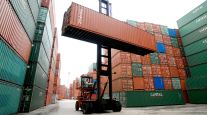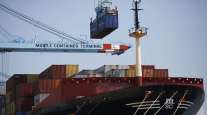More Business Awaits if Intermodal Service Improves Further
FORT LAUDERDALE, Fla. — Railroads have made progress in enhancing service quality this year, compared with last year’s delay-plagued operations, but they will have to keep improving to win more business from customers, shippers said.
Executives from flooring maker Shaw Industries, LG Electronics and Ryder System’s unit that manages freight for other customers delivered that message at the Intermodal Expo here while illustrating the consequences of delays and inconsistent service for the overall truck/rail business.
“There is a lot of opportunity for intermodal,” said Ben Ball, director of transportation services for Shaw, whose percentage of freight used for intermodal slipped to 18% from 23% before rail service difficulties began. “The reason [the percentage] got down so low is because of the service levels.”
“2015 [service] has been much better than 2014,” Ball said, noting the only problem Shaw had was with some drayage services. That problem has been resolved, he said.
Shaw was forced to use more trucking and shift away from intermodal, he said, because Shaw’s customers have become more demanding in terms of meeting reliability requirements.
“Our customers are becoming more and more demanding,” said Denis Marion, director of U.S. transportation for LG, referring to meeting transit time standards that set by the retailer in conjunction with customers.
Marion illustrated the consequences of service failures by saying that LG spent $1.5 million to cover costs for failing to comply with customers’ service requirements. Those failures are holding back more use of intermodal, particularly for shipments directly to retailers.
“We need a little more understanding from the railroads to allow us not to be late” with deliveries he said. At the same time, he said, inconsistent intermodal service that delivers two days earlier than expected creates risks by leaving a load worth $250,000 sitting around in a terminal somewhere.
“We really need as an industry to look for opportunities to improve,” said Paul Boothe, who manages $5.1 billion of transportation spending for Ryder. “We can’t convince customers to make the switch [to intermodal] with 82% or 83% on-time performance.”
In spite of service troubles, Boothe said Ryder has raised spending on intermodal to about $105 million this year, and will try to increase that spend. However, that represents only about 2% of overall spending for its customers through contract and dedicated services.
Like the Ryder official, Marion also stressed opportunity.
“I am a big believer in rail,” said Marion, who uses intermodal for 25% of LG’s domestic moves. “We are still pushing every lane we can move to rail. There are always additional growth opportunities.”
Boothe also told attendees intermodal equipment location needs to become more easily visible for customers, and railroads need to do more to deal with terminal space limitations to improve service.
Bill Clement, assistant vice president of intermodal for CSX, tried to put the market situation into a broader perspective.
“Despite the service issues and despite the implosion of oil prices, we are still growing the market,” he said, to the point that truck-rail freight now is 40% of all CSX moves, up from 33% just five years ago. The railroad is hoping intermodal will reach 45% to 50% of all freight in the future, he said.




